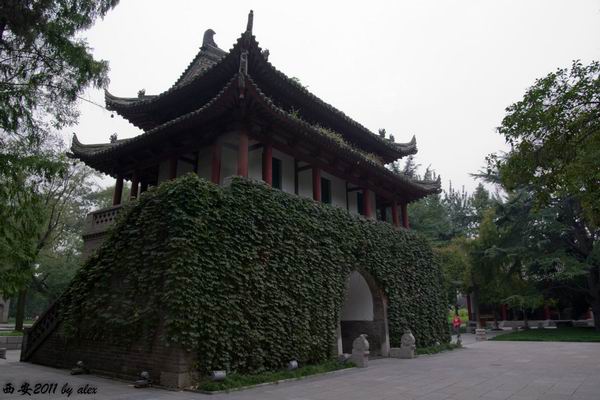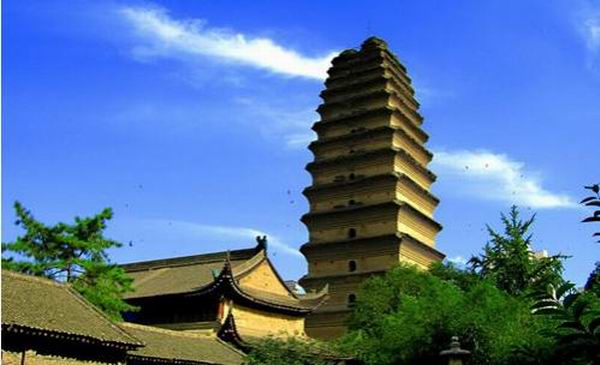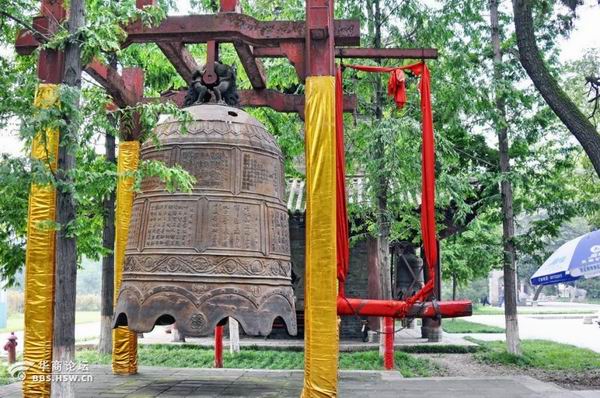The Small Wild Goose Pagoda
Brief Introduction
The Small Wild Goose Pagoda is located the in Jianfu Temple about one kilometer south of Xi‘an.Along with the Big Wild Goose Pagoda, it was an important landmark in Chang‘an, the name of Xi’an capital city in the Tang Dynasty (618-907). Since it was smaller and built later than the Big Wild Goose Pagoda, it was named the Small Wild Goose Pagoda.
The Small Wild Goose Pagoda was built in the year 707 A.D during the Tang Dynasty. Unlike the grand Big Wild Goose Pagoda, it is dainty and exquisite in its appearance. It is an important cultural relic and one of the remaining symbols of ancient Chang‘an.
Covering an area of 16.3 hectares (40.4 acres), the Small Wild Goose Pagoda Scenic Area mainly consists of the Xi’an Museum, the ancient Jianfu Temple built in the year 684 A.D during the Tang Dynasty (618-907) and the famous Small Wild Goose Pagoda. The Xi’an Museum in the west displays more than 2,000 precious historical relics. In the central axis, there are the White-Clothing Pavilion, the Small Wild Goose Pagoda, the Sutra Depository, the Mahavira Hall (Daxiongbaodian) and the Maitreya Pavilion in the Jianfu Temple. Verdant trees, grass and beautiful flowers can be found throughout the time-honored building complex. Moreover, beside the museum sits a big circular square and an artificial lake with two stone arch bridges featuring delicate designs.The scenic area has become a wonderful leisure site for the appreciation of cultural relics, sightseeing and entertainment.
Back Ground Knowledge
Jianfu Temple
The Jianfu Temple, originally located at Kaihuafang of the Tang Dynasty Chang‘an, was former residence of Princess Xiangcheng, a daughter of Tang Emperor Taizong. It was originally established in 684 in hornor of Li Zhi -- Emperor Gaozong of the Tang Dynasty -- and its original name was the Xianfu Temple, which changed into the Jianfu Temple in 690. It was a famous temple in Chang‘an City of the Tang Dynasty.

The temple was the place where the great translator Monk Yijing of the Tang Dynasty translated Buddhist scriptures. Yijing set out by sea for India in search of Buddhist principles in 671. After traveling over 30 countries for 25 years, he came back to China with some 400 volumes of holy Sanskirt scriptures, and stayed in the Jianfu Temple. Yijing translated altogether 56 volumes of scriptures in the Jianfu Temple and wrote the bookBiography of Eminent Monks of the Tang Dynasty in Search of Buddhist Truth in India, which is of great help to the study of Chinese and Indonesian history and the cultural exchange. Now the only extant ancient architecture in the Jianfu Temple is the Small Wild Goose Pagoda.
Legend of the Pagoda
There is a story about how the pagoda was built . When Yi Jing appealed to the imperial court for funds to build a pagoda , so as to preserve the Buddhist scriptures , the Emperor Li Xian asked the Empress for advice as he often did . When she heard of this, she ordered all the imperial concubines and court maids to donate money for the construction of the pagoda .The ladies were so generous in their donation that there was still money left over even after the project was completed .
The “Magical Healing”

There is a story about “magical healing” of the pagoda . In 1487, an earthquake of six points happened in Shaanxi Province . As a result , the pagoda was left with a one-foot crack(一from the top to the bottom .Thirty-four years after the quake , there was another one ! Amazingly, the crack healed overnight . The process was later called the “magical healing”. However , when repair work started after 1949 , it was found that the healing was not “magical” , but “human” .The pagoda has survived seventy quakes , and it still stands as firm as ever.
The Small Wild Goose Pagoda
The pagoda is a multi-eave and square brick structure. Originally it was 46 meters high with 15 storeys, but now it is 43.3 meters high with 13 storeys, because its steeple was destroyed, as a result of earthquakes. Carved on the lintel are images of arhats and designs of grasses, with excellent workmanship reflecting the artistic style of the early Tang Dynasty. The pagoda has fifteen painted roofs. Each storey is very low with small windows only on the south and north sides to let in light and air. The eaves are formed by designs in the shape of chevrons and fifteen tiers of overlapping bricks, each tier wider than the one below, thus making the eaves curve inward, a characteristic of multi-eave pagodas in the Tang Dynasty. From the first to the fifth storey it tapers very little, but from the sixth storey up, it reduces drastically, giving the pagoda a smooth curved contour. The tubular interior of the pagoda has wooden flooring and a winding flight of wooden steps leading to other storeys.
The shape and structure of the pagoda are typical of early multi-eave pagodas and influenced many brick and stone multi-eave pagodas built later in other parts of the country.
Morning Bell Chimes

Inside the temple , there is a huge iron bell . The sound of the bell is crisp and pleasant , and can be heard as far as five kilometers away . The local natives often call it the “Magic Bell”. It is 4.5 meters in height and 10 tons in weight .It is said that if one missed his beloved relations far away from him , the only thing he could do was to write their names and addresses on a piece of yellow paper , and the sound of the bell would pass the message to them . The Small Wild Goose Pagoda is well-known for its “Morning Bell Chimes”. It used to be one of the Eight Famous Scenic Attractions in the central Shaanxi plain.
Museum
Covering an area of 245 hectares, the museum was officially opened to the public in May 2007. This museum collectively reflects the long history of Xi’an city.
The culture exhibition hall, as the main building of Xi’an Museum, was designed under the charge of Mrs. Zhang Jinqiu, the famous designer, academician of the Chinese Academy of Science, designer of Shaanxi History Museum. In the activity advocated by the news media of 2004, this building was selected as one of the ten symbol architecture of Xi’an in future. The museum covers the floor space of over 16, 000 square meters, exhibition area of over 5, 000 square meters. The exhibition of Xi’an Museum consists of the basic exhibition, specific theme exhibition and temporary exhibition. Out of the 130, 000 pieces or sets of collected culture relics, 14, 400 pieces or sets are cherished culture relics, exceeding national standard of third class.Almost 2,000 pieces or sets of relics are exhibited to the public for the first time. The extraordinarily splendid, various culture relics mark the different aspect of Chinese ancient history.
Tips
|
Location
|
No. 72, West Youyi Road, Southern Xi’an
|
|
Drive Distance
|
one kilometer (ten minutes) away from the center of the city
|
|
Opening Time
|
9:00 to 17:30
|
|
Closed on every Tuesday
|
|
Ticket Price
|
Free (Get the ticket with your passport.)
|
|
Visiting Time
|
one hour
|










